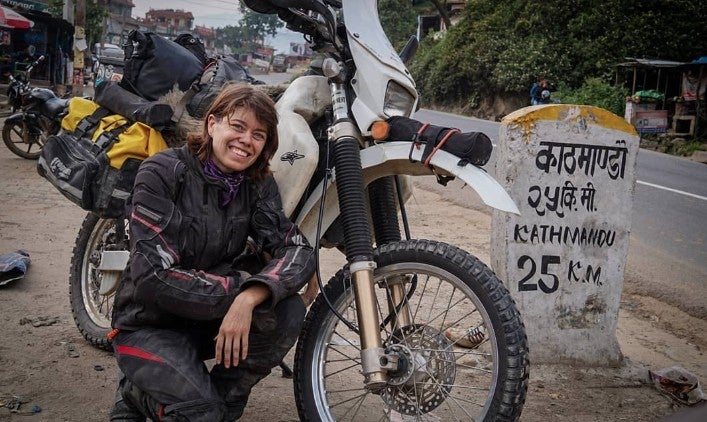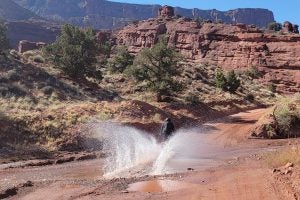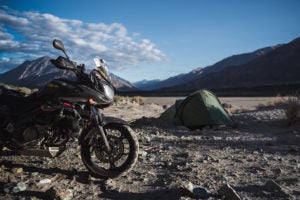There is a growing narrative with RTW riders and overlanders to show you all the amazing things that are happening to them, the incredible things that surround them daily, idyllic places they stay, where’s the honesty? What about riders that are doing some crazy pointless record attempt simply for the ‘look at me’ props, records that honestly no one cares about, but maybe Guinness and Aunt Dorothy.
Is RTW travel really like this, and perfect Every. Single. Day?
No!… so it’s actually refreshing to find a rider who is completely honest, open and willing to show the more negative realities of long-term travel.
Some people do live a charmed life, and have an amazing time with zero issues for the duration they are on the road, but some don’t…Heather Sinclair is in the latter group and she is not afraid to tell you EXACTLY how rough RTW travel truely can be…
ADVrider: Tell us a little about you as a person that readers might not know?
Heather: I’m pretty open on social media, so I’m not sure there’s much that people don’t know, but probably the thing that people may not realize is that I’m actually far more introverted and socially awkward than most people seem to think. Sometimes it can be a bit of a challenge traveling day to day when I’m often the center of attention and I really just want to retreat to my hostel bunk by myself!

Relaxing after getting back from Colombia. Photo: Heather Sinclair
ADVrider: When did you get into riding, and why?
Heather: I actually came to riding relatively late in life. I had started riding a scooter a few years into my 30s in California, but it wasn’t until I was sent to India for a few months for work that I actually rode a geared motorcycle for the first time.
We set off before dawn to beat the worst of the traffic, but my luck only lasted until later in the afternoon when we got to the hill station of Yercaud. I was heading around a bend and came face to face with a bus that was overtaking around a blind corner. I managed to get out of the way in time, but not without flying over the handlebars in the process.
While my first day riding a motorbike may not have been the most auspicious start, I discovered that it was an amazing way to travel and see India.
ADrider: What was the turning point in your life to make you hit the road?
Heather: Since that first day in India, I had it in my head that I wanted to go back on my own bike, but I never really acted upon it until years later. I had found myself now working in London with an unexpected severance package and a lot of time off, so I decided to take off right then.

Turkmenistan was one of the weirdest countries I visited. It remains closed to tourism since the pandemic. Photo: Heather Sinclair
ADVrider: Most people hit the road on a bike they owned already; was this the case with you?
Heather: Because my decision to start was extemporaneous, I didn’t have a prepared bike, but I didn’t want to take the months it would require to prepare one, nor did I have the time and the skills to do such a thing – living in London means that I had no garage, and local mechanics haven’t the time, space, or patience for lengthy overland preparation.
At the time I owned an old BMW 650GS which is surprisingly heavy but was also in extremely poor condition from having been stolen (and recovered!) twice, so wasn’t suitable for the trip.
ADVrider: You have had a couple of travel bikes; what was the first, why did you choose it, and where did you ride to/ from?
Heather: Since the BMW was out of the question, I had to find a replacement. I put together a spreadsheet comparing all my available options regarding weight, horsepower, service intervals, etc., and the spreadsheet told me that I should buy a DRZ400S.
I did the eminently sensible thing of buying a seven-year-old DRZ with an unknown history, which I rode for only about 200 miles in total before putting it in a crate and shipping it off to Indonesia.

Soldiers’ hut in no man’s land. Photo: Heather Sinclair
ADVrider: What were the challenges for your initial route, logistically speaking, and in hindsight would you take the same one if you were to do it again, or is it even possible anymore?
Heather: Indonesia back to the UK had several logistical challenges when compared to other popular overland routes. Visas, some of which got denied (Pakistan), mandatory guides (Myanmar and for me, Thailand), shipping, and of course the carnet de passage, which if you live in the UK and have to go through CARS is a rather expensive piece of paper indeed.
The only thing I would have changed would have been to try harder to find a way when my Pakistan visa was denied, rather than resorting to shipping around Pakistan and China. But the rest of it? There is no place in the world like Asia, nowhere else do you see the sheer variety of humanity in all its weird and wonderful forms.

Replacing piston rings on my DRZ in France. Photo: Heather Sinclair
Each border is a different language, a different religion, culture, national dress, alphabet—everything. And now looking back that route is no longer possible at all, and may never again be. I’m glad I took the chance when I did.
ADVrider: Later in your travels you were headed to Africa; you made it onto the continent, and then what happened?
Heather: After I got back to London from Indonesia, I was out of money with a bike that was barely running. I spent the next year and a half fixing those two issues (learning mechanics from scratch from YouTube and a Clymer manual) and decided to set off again—this time to Cape Town.

Photo: Heather Sinclair
I left from the Overland Event Winter Warmer, in the midst of one of the biggest storms in years. I am not one for auspicious starts it seems, but a storm paled in comparison to the fact that I had chosen possibly the worst month and year to begin a big trip: February 2020. I got to Morocco just in time for a very long, extremely strict lockdown. I wasn’t allowed to leave the country nor the Airbnb I ended up in for four months. To be honest, I’ve never entirely recovered psychologically from the experience.

Photo: Heather Sinclair
By the time the lockdown lifted, all of us foreigners who had been stuck in the country overstaying our visas were told that we needed to leave. I ended up in Chefchaouen, in sort of a budget Rick’s Cafe run by a German named Uli, with a motley array of overlanders all trying to jam onto one of the few ferries back to Europe. That night, sailing across the Mediterranean on our way to France, we bought all the whiskey on the ferry and got incredibly hammered. The next morning was such a blur that I tried to speak Arabic to the French border guards.

August 2, 2020, when I finally escaped from Morocco. Photo: Heather Sinclair
ADVrider: After reworking your route, you also changed bikes, why? … and how did you decide on your next bike?
Heather: By the time I got back to the UK (and lockdown #2), my poor DRZ was once again showing the signs of the abuse I had put it through—some self-inflicted, some not.
There was no way the bike would survive another cross-continental journey, and I didn’t have the appetite to spend another year rebuilding it, so I took the decision to buy a new bike.
I didn’t want another used bike where I’d inherit someone else’s problems, but the options available for a new, sub-200kg, travel-worthy bike are slim at best in Europe. Carbureted bikes like the DRZ or DR650 haven’t been sold here since 2008.
I had heard of AJP a few years before—even encountering one in the wild when I bumped into overlander Bart at the Krygz Tajik border some years before.

Taking my new AJP PR7 on a shakedown run to Scotland. Photo: Heather Sinclair
At the time, I thought it was a KTM with a weird color scheme! An unknown bike, from an unknown brand I had initially dismissed outright, but the more I looked the more I learned that it was a bit of a Frankenstein bike in a good way—and the parts were coming from other, much more common bikes, so parts and spares would not be nearly the problem that one might think.
It had everything I wanted for a travel bike; a rally fairing, comfortable seat, decent power, decent range, and a service interval that is much better even than the stated intervals in the manual. By the time I did a quick test ride, it was sealed. The bike was an absolute joy to ride and I was hooked.
ADVrider: Your travels brought you to America; where did you go, and how was life on the new bike?
Heather: I travel to challenge myself … so I decided to do a route far more extreme than what I had one in the past—riding the Trans America Trail end to end.
The PR7 was absolutely brilliant for this kind of riding, and I found myself going faster, and tackling harder terrain than I would have on my DRZ because the bike was so much more confidence-inspiring.

Battle Beach Oregon, the end of the Trans America trail. Photo: Heather Sinclair
ADVrider: After America it was southbound, and things went wrong, seriously wrong. Could you share the experiences good and bad, and maybe some words of wisdom?
Heather: After the US I made it very slowly down through Mexico and Central America over the next six months, shipping by sea over the Darien Gap.

With Coco. Photo: Heather Sinclair
The rainy season had hit early by the time I got to Panama, and backlogs in the seaport meant that my container was delayed by three weeks. My bike sat in a steamy, hot container the whole time, which did a bit of a number on my electrical connectors.
I discovered the hard way when my wiring loom caught on fire only 200 km away from Cartagena.
Unfortunately, as I’ve learned more about mechanics, the problems I’ve had have only increased in complexity, and I had to get pushed to a local mechanic to get my wiring fixed as I couldn’t do it on the side of the road. The mechanic got someone to fix my wiring but then was insistent that the root problem was with my stator. I was confident that it was not, but he wore me down to the point that I figured that I might as well let him check, just because I didn’t want to be stuck somewhere in the long 500 km stretch between the village and Medellin.
The mechanic was, of course, wrong, and furthermore, absolutely buggered up the job of taking off my stator cover, mangling my gasket, and dumping out half my oil. He topped it up but left me with an oil leak that turned out to be far faster than I expected, even though I habitually check my oil levels every day. (A legacy of many long miles on a DRZ). By the time I got to Medellin, unbeknownst to me, my bottom end was already failing due to oil starvation.
AJP was great and sent me parts for the rebuild, but then the big bike mechanic in Medellin messed up the rebuild, then couldn’t figure out what was wrong with it, then eventually gave up, leaving me with a bike that could barely get to 50 km/h. I did my best to check everything I could in the hostel parking lot, but my limited tools and limited workspace meant that I couldn’t progress past eliminating the obvious issues. By now I had lost faith entirely in local mechanics and I didn’t want to waste my time with a mechanic after mechanic just re-doing everything I had already done. It had already been 2 months and I was fed up.
The mechanical issues though, honestly, were less the impetus for my decision to end my trip than they were the straw that had broken the camel’s back. Inflation had meant my budget was no longer even close to sufficient to get me down to Ushuaia and ship back, even after I whittled my travel lifestyle down to little more than my tent, pasta, and petrol. Besides that, I just wasn’t finding the joy in Latin America that I had experienced in Asia, Europe, or Morocco. Each border felt less like the opportunity to discover something new and wonderful but rather just more of the same. Maybe I was reaching the point of diminishing returns with motorcycle overlanding. I decided to ship the bike back, which turned out to be a month-and-a-half-long debacle where I was very close to having no option but to abandon the bike entirely.
The last, final option after air and container options failed was Ro/Ro (roll on, roll off open freight shipping), which is not ideal when you have a bike that barely starts and barely runs yet needs to be ridden by port workers on and off the boat.
At this point Heather apologized for the lack of photos she could share telling me about one of her last encounters in Colombia – “I don’t have many, because I wasn’t in a mood to take pictures then my phone got stolen at knifepoint so I couldn’t take pictures even if I wanted to”
If there are lessons to be learned from my experience I don’t know what they are, other than perhaps a resignation that I’m a bit of a shitmagnet (as you can probably tell by this account). Maybe the conclusion is to treat overland bikes as little more than a simple tools to be bought and abandoned without sentimentality.
ADVrider: Where would you consider the toughest area you’ve ridden, and why?
Heather: Probably heading up California Pass in the Rocky Mountains. I had gotten onto the wrong line and dropped my bike on the steepest section in a bit of rough scree. I had pushed too long that day, so started already tired. No matter how many times I picked the bike up again in the thin air I couldn’t get it out and going again without sliding backward and falling.

Photo: Heather Sinclair
The pass isn’t even all that difficult, it’s just being solo at that altitude in those conditions, things can spiral out of control. I was frustrated and exhausted, and I was very, very lucky to have a group of quads and then bikes come by to help. It ended up taking four guys to get it turned back around again so I could abandon the pass and head back to Silverton.
ADVrider: What was the scariest moment on your travels?
Heather: I’ve been robbed at knifepoint, faced armed blockades, ridden some absolutely mental roads, and been hit by a bus, but luckily managed to get out of these situations without anything worse happening.
The one time I thought that I had truly gone in way over my head was when I was invited to camp out with Kyrgyz soldiers in no man’s land between Kyrgyzstan and Tajikistan. They were kind, but it was already too late by the time I realized that one of them had a rather specific notion of American women and thought that now was his best shot to realize these notions. His colleagues didn’t seem like they had any interest in dissuading him of this either, but luckily it didn’t go further than him trying to cuddle with me in the middle of the night. I’ve learned over time how to be very firm in these sorts of scenarios. I’m not sure how much it helped here—it probably did, but it does mean when I’m frightened I absolutely cannot let it show.
ADVrider: Most memorable day?
Heather: You ask that question knowing that it’s impossible for any overlander to pick just one! I’ve had days that were memorable for good reasons, others that were memorable for maybe not-so-good reasons, or days that were memorable off the bike. To choose one in a way feels like it would diminish all the rest.
ADVrider: As you’ve used a couple of bikes people consider ideal lightweight travel bikes, would you pick either of them again or something different if you had an unlimited budget?
Heather: Probably not.
The AJP is a joy to ride, but the unfortunate fact of the matter is that I can’t reliably pick up a 200kg+ motorbike in the conditions I would want to ride in, and the sub-200kg bike market requires far too many compromises to make any of them a great choice. Yes, I could get a Honda CRF300, but why bother if I’ll be bored and have to flog it just to try to keep up with other riders?
Yes, I could buy another, less reliable bike, but as a shitmagnet I’m just signing myself up for more mechanical misery, which I’m rather tired of.
Yes, I could buy a more road-oriented bike, but then I wouldn’t be able to go where I wanted to go and do what I wanted to do. I’ve had both joy and headaches on the bikes I’ve picked, but I don’t believe there’s a bike out there that would give me a better ratio of joy to headache.
ADVrider: Is motorcycle travel going to happen again for you in the near future?
Heather: I don’t think so. I don’t think it’s a very good time to travel right now, and the economic situation has left me less comfortable in my ability to continue to live semi-retired on just my investments.

With my non-functioning AJP. Photo: Heather Sinclair
It is much better right now for me to focus on saving for the next few years. After that, I may go for some relatively shorter trips (2-4 months at a time) via a motorcycle that doesn’t require shipping, but I’m almost certain my next big trip will be of another type entirely.
I’ve had some wonderful experiences on motorcycles, and the experiences have made me grow as a person, but the world is far too big and wonderful, and life is too short to spend it all just on a motorbike.
Heather now has been reunited with her AJP back in the UK, and it needs serious repair. You can help by buying a copy of her book to get her one part closer to it being ‘road worthy’ again. Amazon link to the book








